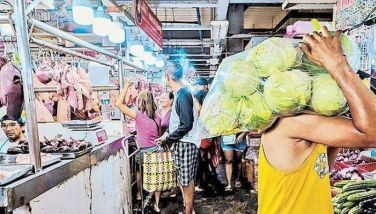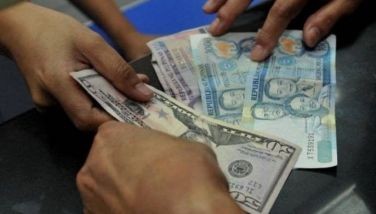Boom or bust?

Is the Phl going back to a cycle of boom and bust?
Over the last few weeks, I have been getting so many messages of wild speculation.
One, that the President is sick, or that martial law will be declared. The list goes on and on to include other unfounded assumptions and fears. It’s easy to ride on the panic and say – “start buying dollars, start unloading your properties, sell all your stocks and bonds!” But in the end, doing so may be a grave mistake.
With the concerns of inflation and the panic surrounding it, I always remind the people to see the bigger picture. Look at the long-term goal.
Like any other competitive country, the Philippines is not expected to follow a straight path to success or growth. There will be delays and bumps – and, at times, even big bumps!
Martial law babies and the generations before us can attest, no matter the bumps, these can be overcome – like the Asian Financial Crisis of 1997, and the financial contagion spawned by the Lehman collapse in 2007-2008, which led America to experience its worst depressive period in modern times. The stock prices in the Dow index at that time fell to an appalling 3000.
Ten years after that, during the US subprime crisis, the American stock market dropped to about 26,000, or 10 times from the low. And likewise, even our own Philippine stock market saw a huge turnaround from below 2000 level some years ago to the present 7000 level.
So what can we learn from these events, from history? There is hope. Though we may be experiencing a low now, we can – through good governance and leadership – navigate through current challenges and come out stronger and more robust.
First of all, to understand what it is happening to the Philippines, we have to first delve into the government’s agenda.
Our government has a vision of a faster economic growth through intensified infrastructure spending. No one would argue that our country needs more infrastructure, since it is the key driver of economic prosperity. Even China envisions more economic growth by interconnecting itself to Europe and Asia through its massive Belt and Road infrastructure initiative.
Speaker Gloria Macapagal-Arroyo, during her time as president, also invested in connectivity through her RORO project, while the Aquino government did a great job in managing our country’s financial health, allowing us to obtain a historic investment grade rating. (But it’s important to note that its own infrastructure spending program at that time was bogged down for one reason or another.)
My point here is that to be able to push forward the Build Build Build program as an engine of growth, the country needs to roll out infrastructure projects immediately. Like a corporation, the Philippines needs to invest first, before it can reap revenue. Consider the Philippines as a company – call it Phil Inc. – with the citizens as the shareholders and the Cabinet, legislators and other offices as the management team, with President Duterte leading as CEO.
This massive capital expenditure for Phil Inc. is important for us to attain our continued growth, and it’s imperative that we build the infrastructure – airports, roads, bridges, ports, and railways – immediately to serve as the conduit for economic success. We can see the great implications of this already in tourism as it can help us provide better services and products, helping small-time entrepreneurs along the way. Roads will allow the easier delivery of products from farms to markets, which will also lead to a greater development in agriculture. Also, provinces have the chance to develop into large cities.
Every country in the world has adopted this same pathway. Through a more comprehensive infrastructure plan, you create a more inclusive economy. But in order to do that, you have to spend and invest, which on a national scale means relying on taxes.
So yes, taxes have caused inflation. We will shoulder excise tax on fuel and petroleum products, sugar tax on sweetened products, and tax on cars, among others, but looking at the bigger picture, this is our contribution to this big investment.
The Sugar Regulatory Administration (SRA) should have pushed for the importation of sugar, as the soft drink companies using fructose (which has higher taxes) have been forced to switch back to cane sugar, further causing this sugar shortage. This in effect has raised the production prices of almost every product out there – from 3-in-1 coffee to juices, bread, etc. Rice, for one, is at its high. Managing the right balance of imported and local supply is important so as to have the right effect on the price and produce of our farmers.
To slow down inflation, the Central Bank will also have to be more aggressive in increasing interest rates. It’s important to remember that inflation is caused not just by one factor; some of the causes of inflation today are due to external, cost-push drivers like oil prices and other commodities, which may reverse trends and hopefully tame inflation next year.
In my opinion, speaking from the point of a CEO, today’s inflation and peso depreciation are to be expected. But that doesn’t mean we must throw ourselves into panic. This happens even in the private sector and among entrepreneurs. As we expand, we make adjustments, but the vision does not change.
President Duterte has had a good streak of respectable economic growth rates over the past two years, but there is still a long way to expand the economy. The Build Build Build program is a great first step in enticing more development in the countryside through tourism and manufacturing. But the cost of this capital expenditure runs in the trillions of peso.
In a corporation, the financing of such expenditure will come from several sources – the shareholder contribution, equity in from of taxes, coupled with debt financing though government borrowing. As in private companies, there is a healthy balance between equity and debt and the CEOs and managements are always mindful of striking a healthy balance. Our government normally watches its debt to GDP ratio so that the loans of the country do not heavily weigh on the revenues of the country. Over-leverage and weak earning capacity are a volatile combination.
Good thing is that even as the government plans to borrow more to finance the infrastructure investments, the gross international reserves of the country (this is analogous to the external cash buffer of the country to be used for paying foreign loans and financing imports), is at $77.7B, as of end June 2018. This level of international reserves can finance up to 7.5 months of imports of goods and services, or six times the country’s short-term debts. During the financial crises of the 1990s, our reserves could only finance three months’ worth of imports, which is to say that our government’s cash buffer is twice as strong now compared to the crisis years of the 1990s.
Then again, even as the government has room to borrow, it is unable to borrow to finance all the needed projects today. And this is where private money – through the PPP can be used to supplement government borrowing to fast track needed infrastructure projects. Of course, doing PPP also is like a form of tax, because an airport that is built through PPP (and not through the use of tax money or government loan) will eventually have to charge airport users so that the PPP investors can recover their capital with reasonable return. Under the PPP, the shareholders of Phil Inc. may not be required to pay upfront in the form of taxes, but they (or the airport or toll road users) will pay eventually under the pay-as-you-use scheme of PPP.
I believe the Philippines is blessed to achieve continuous growth, and we must remain supportive. I continue to remain bullish as our very own company, RFM Corp., celebrates its 60th year on October. My grandfather Salvador Araneta loved the Philippines and was in the early days of the government. My father JoeCon, who is turning 87, has always had the “Yes, the Filipino can” attitude. Today, I find myself helping thousands of micro and small entrepreneurs and guiding them towards success.
With all that’s happening today, let us not forget the bigger picture. Let’s remain bullish about our own country. Failure is not an option for the sake of our Filipino people.
- Latest
- Trending



























